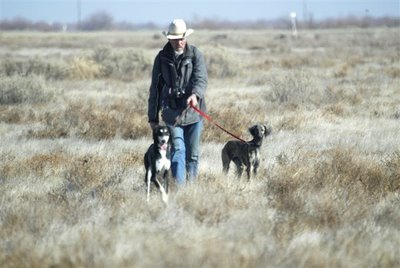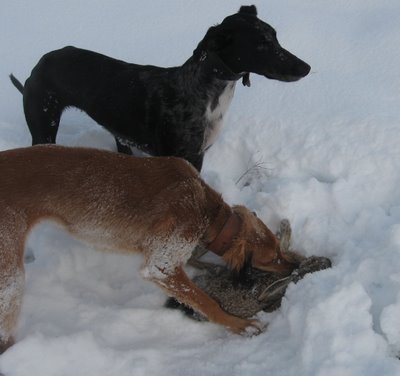Like catch-and-release fly fishing, there is such a thing as catch-and-release falconry. It is not so widespread a practice among falconers as it is among anglers, but its practitioners espouse many of the same arguments in support of it. For what it's worth, I strongly disapprove.
This week I received a very cordial letter (actual words on paper!), with a collection of vintage hawking photos and copies of two articles, all by a longtime falconer from the Southwest. The letter expressed the author's concern, or maybe just his puzzlement, about my position on catch-and-release, which I outlined a couple years ago in an essay printed in our falconers' association newsletter.
My correspondent is no fake falconer. He has been hawking successfully since before I was born. His articles are well-written and sincere, and correctly point out the fact that some falconers have been releasing game systematically for centuries. There was once an entire branch of our sport dedicated to catching herons and other large, "uneatable" birds, ringing them for posterity with a metal band and then releasing them. Purely sporting.
My reply to this falconer follows. I reprint it here with Steve's blessing, because I think it touches on some issues that define our sport and that frame my own defense against anti-hunting / anti-cruelty sentiment. Naturally, I don't expect the anti-crowd to split these hares, but it's useful to me, at least, to know where I stand.
I wrote:
"... I was, as you guessed, very interested to see your accounts of catch-and-release falconry. My opposition to releasing live game is not categorical. I have hastened to pull my hawks off “miscellaneous” animals, especially dangerous ones such as cats and raccoons that are sometimes taken by accident. My intention is foremost to save the hawk from harm and, if possible, prevent any harm to the prey animal also. These are exceptional circumstances, more frequently occurring with very young hawks and rarely after a good first season of successful hunting. Since I tend to fly the same individual birds for multiple seasons, this doesn’t happen often.
Another, perhaps related, circumstance would be one in which a prey animal manages to escape numerous attempts on its life by the hawk, yet remains “catchable” in some vulnerable refuge of last resort. These are frequent enough situations, as you know. In these cases, if I do not need food for the hawk or want it for myself, I’ll leave the animal alone, knowing it might not be so lucky next time.
That said, my goal at the onset of every hunt is to kill what I’m hunting. The pleasures of a day in the field with a hawk are manifold (of course!), but the point of the day, in my opinion, is to seek, find and catch what I’m after.
My goal is not the glory of the flight. Falconry is not primarily an aesthetic pursuit for me. I hope that doesn’t sound monstrous! I place a high value the art of falconry, but I expect it to emerge as a natural outcome of the hunting, not the reverse.
My feeling is this: My hawk is serious about his hunting. My dog is serious about hers. The prey is deadly serious about getting away from us. Who am I to take this situation so lightly as to make it into a game? You asked: “Who says falconry has to be a blood sport?” I say the animals do, and so do I.
Compassion, moderation, conservation—these are not alien concepts to me. I understand that catch-and-release falconry is often explained as a humane means of enjoying sport today while preserving it for the future.
But my approach to honoring these ideals is, instead of hunting and releasing caught game, to cultivate an appreciation of natural limits. The natural limitations of falconry include the hawk’s fitness (and mine), its skill as a hunter (and mine), the hawk’s appetite, the weather, our available land and the abundance of quarry, to name a few. My personal definition of success in hunting serves as another limitation: A hunt is successful when it ends in a kill. It is not necessarily more successful with multiple kills, but depending on one’s goal for the day (e.g., stocking the summer larder, or building drive in a young hawk), more is sometimes better. In either event, the hawk’s desire to kill motivates the hunt, and its willingness to continue—not mine—sets the limit.
When do we stop? That’s the question for which the sport’s natural limitations provide the best answer. Were I to rely on my own, sometimes insatiable, appetite for hunting to inform me when it’s time to call it quits, I might never leave the field! As Joan Osborne sings it, “How can a man let conscience be his guide, when it’s he who must keep it satisfied?”
Nothing my hawks kill is wasted. The quarry feeds the bird or both of us. The hawk eats no more than it needs from day to day, and I freeze no more than I will use before the next hunting season begins. I hunt a series of several fields in rotation, switching to the next if slips become scarce—although I have never exhausted any of my fields, as years of consistent daily bags show. My belief, based loosely on my experience studying the ecology of wild raptors (three wonderful years tracking radio-marked Cooper’s hawks, dawn to dusk) and also on the accumulated hawking experience of myself and friends, is that game populations need no special protection from falconry. Conservation is served by matching the right hawk with the right quarry (usually meaning its natural prey) in its native habitat, and by following the natural limitations of the sport.
As I get older, I appreciate these limitations all the more. I now practice a form of falconry that requires little driving and a lot of walking. It needs no gadgets or electronic aids; it is extremely low-tech hawking. My commonest quarries include small birds and rodents, which my hawk eats on the spot. A typical hunt entails a hike in a wide circle of fallow cow pasture and ends when the hawk is full. With a young family to look after, I hunt no more than four days a week, and I can manage only a single hawk.
So I see moderation and conservation as integral to my falconry, despite the fact that I do not release what we catch. But what about the “humane treatment” of our prey—is that enhanced by letting it go?
I don’t think so. My pet phrase for the reason why is that “there are no barbless hawks!” True, the largest animal that any hawk is capable of catching can sometimes be released without apparent harm. But I doubt (after cleaning thousands of animals brought to bag by hawks) that “apparent harm” is the same thing as “no harm.” If its talons are sharp, and its appetite and physical condition are good, my bird can be expected to do considerable harm to its prey in a short period of time. It is literally trying to kill the animal, and it is well equipped to do so.
I disagree that we can assume released prey runs or flies away no worse for wear. But let’s imagine, for a minute, that it invariably does so. What have we then accomplished? In my view, we have accomplished by catch-and-release the reducing of our grand, natural sport to a mere human game. We have ignored the serious intentions of our good hawks and dogs and shown such disrespect to our quarry that we would, in effect, be risking its pain and discomfort to satisfy our aesthetic needs and nothing else. We deny our prey the basic honor of escaping by virtue of superior ability on the one hand, and the gift of a swift dispatch on the other. Say: Do we think this duck is not going to die another day? Do we imagine that the wild hawk or owl that finally does it in will consider its pain while eating the bird to death?
In my view, if we intend to hunt at all, killing what we catch is the most “humane” course. While my tiercel Harris’ hawk is well equipped to catch and mortally wound a rabbit, I’m better at killing one quick. Moreover, I’m the only one of us who gives that a moment’s thought.
I hope the above rambling provides some answer to your inquiry about my feelings. Please note, there are certainly no hard feelings on my end and no serious disagreement over this topic, which must remain a matter of personal choice.



















